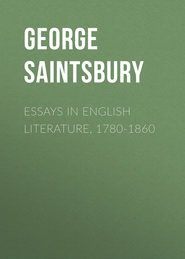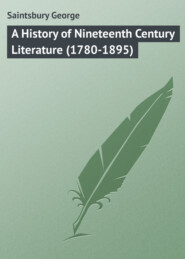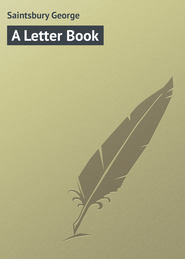По всем вопросам обращайтесь на: info@litportal.ru
(©) 2003-2024.
✖
A Short History of French Literature
Настройки чтения
Размер шрифта
Высота строк
Поля
The first collection of Fabliaux was published by Barbazan in 1756. This was re-edited by Méon in 1808, and reinforced by the same author with a fresh collection in 1823. Meanwhile Le Grand d'Aussy had (1774-1781) given extracts, abstracts, and translations into modern French of many of them. Jubinal, Robert, and others enriched the collection further, and in vol. xxiii. of the Histoire Littéraire M. V. Le Clerc published an excellent study of the subject. A complete collection of Fabliaux has, however, only recently been attempted, by M. M. A. de Montaiglon and G. Raynaud (6 vols., Paris, 1872-1888).
61
Fabliau is, of course, the Latin fabula. The genealogy of the word is fabula, fabella, fabel, fable, fablel, fableau, fabliau. All these last five forms exist.
62
It should be noticed that this title, though consecrated by usage, is a misnomer. It should be Roman de Renart, for this latter is a proper name. The class name is goupil (vulpes). The standard edition is that of Méon (4 vols., Paris, 1826) with the supplement of Chabaille, 1835. This includes not merely the Ancien Renart, but the Couronnement and Renart le Nouvel. Renart le Contrefait has never been printed. Rothe (Paris, 1845) and Wolf (Vienna, 1861) have given the best accounts of it. Recently M. Ernest Martin has given a new critical edition of the Ancien Renart (3 vols., Strasburg and Paris, 1882-1887).
63
The necessary expression of the genitive by de is later than this. Mediaeval French retained the inflection of nouns, though in a dilapidated condition. Properly speaking Renars is the nominative, Renart the general inflected case.
64
This is a free translation of the last line of the original, which is as follows: —
Pour renard qui gelines tue,
Qui a la rousse peau vestue,
Qui a grand queue et quatre piés,
N'est pas ce livre communiés;
Mais pour cellui qui a deux mains
Dont il sont en ce siècle mains,
Qui ont sous la chappe Faulx Semblant.
Wolf, Op. cit. p. 5.
The final allusion is to a personage of the Roman de la Rose.
65
Ed. Roquefort, vol. ii. See next chapter.
66
By Dr. W. Förster. Heilbronn, 1882.
67
Leipsic, 1870.
68
See note at end of chapter.
69
This miscellaneous lyric for the most part awaits collection and publication. M. G. Raynaud has given a valuable Bibliographie des Chansonniers Français des XIIIe et XIVe siècles. 2 vols., Paris, 1884. Also a collection of motets. Paris, 1881.
70
Philippe Mouskès. This is it:
La terre fut pis en cest an
Quar li vieux Quesnes estoit mors.
71
The best edition is in Schéler's Trouvères Belges. Brussels, 1876.
72
Rheims, 1851.
73
The most convenient place to look for Adam's history and work is Le Théâtre Français au Moyen Age. Par Monmerqué et Michel. Paris, 1874. There are also separate editions of him by Coussemaker, and more recently by A. Rambeau. Marburg, 1886.
74
By A. Jubinal. 2nd edition. 3 vols. Paris, 1874.
75
Ed. Roquefort. 2 vols. Paris, 1820. The first volume contains the lays; the later the fables, which have been noticed in the last chapter. Later edition, Warnke. Halle, 1885. Marie also wrote a poem on the Purgatory of St. Patrick. Three other lays, Tidorel, Gringamor, and Tiolet have been attributed to her, and are printed in Romania, vol. viii.
76
Lays of France, London, 1872.
77
This is an account of the battle of thirty Englishmen and thirty Bretons in the Edwardian wars.
78
There is, it appears, no authority for the Christian name of Robert which used to be given to Wace.
79
Wace's Brut is not the only one. The title seems to have become a common name.
80
61
Fabliau is, of course, the Latin fabula. The genealogy of the word is fabula, fabella, fabel, fable, fablel, fableau, fabliau. All these last five forms exist.
62
It should be noticed that this title, though consecrated by usage, is a misnomer. It should be Roman de Renart, for this latter is a proper name. The class name is goupil (vulpes). The standard edition is that of Méon (4 vols., Paris, 1826) with the supplement of Chabaille, 1835. This includes not merely the Ancien Renart, but the Couronnement and Renart le Nouvel. Renart le Contrefait has never been printed. Rothe (Paris, 1845) and Wolf (Vienna, 1861) have given the best accounts of it. Recently M. Ernest Martin has given a new critical edition of the Ancien Renart (3 vols., Strasburg and Paris, 1882-1887).
63
The necessary expression of the genitive by de is later than this. Mediaeval French retained the inflection of nouns, though in a dilapidated condition. Properly speaking Renars is the nominative, Renart the general inflected case.
64
This is a free translation of the last line of the original, which is as follows: —
Pour renard qui gelines tue,
Qui a la rousse peau vestue,
Qui a grand queue et quatre piés,
N'est pas ce livre communiés;
Mais pour cellui qui a deux mains
Dont il sont en ce siècle mains,
Qui ont sous la chappe Faulx Semblant.
Wolf, Op. cit. p. 5.
The final allusion is to a personage of the Roman de la Rose.
65
Ed. Roquefort, vol. ii. See next chapter.
66
By Dr. W. Förster. Heilbronn, 1882.
67
Leipsic, 1870.
68
See note at end of chapter.
69
This miscellaneous lyric for the most part awaits collection and publication. M. G. Raynaud has given a valuable Bibliographie des Chansonniers Français des XIIIe et XIVe siècles. 2 vols., Paris, 1884. Also a collection of motets. Paris, 1881.
70
Philippe Mouskès. This is it:
La terre fut pis en cest an
Quar li vieux Quesnes estoit mors.
71
The best edition is in Schéler's Trouvères Belges. Brussels, 1876.
72
Rheims, 1851.
73
The most convenient place to look for Adam's history and work is Le Théâtre Français au Moyen Age. Par Monmerqué et Michel. Paris, 1874. There are also separate editions of him by Coussemaker, and more recently by A. Rambeau. Marburg, 1886.
74
By A. Jubinal. 2nd edition. 3 vols. Paris, 1874.
75
Ed. Roquefort. 2 vols. Paris, 1820. The first volume contains the lays; the later the fables, which have been noticed in the last chapter. Later edition, Warnke. Halle, 1885. Marie also wrote a poem on the Purgatory of St. Patrick. Three other lays, Tidorel, Gringamor, and Tiolet have been attributed to her, and are printed in Romania, vol. viii.
76
Lays of France, London, 1872.
77
This is an account of the battle of thirty Englishmen and thirty Bretons in the Edwardian wars.
78
There is, it appears, no authority for the Christian name of Robert which used to be given to Wace.
79
Wace's Brut is not the only one. The title seems to have become a common name.
80











